Among the variety of clownfish Amphiprion akindynos it stands out for its elegance, restrained color and unique habitat. Unlike the more well-known representatives of the genus Amphiprion, this species does not have a bright orange color, but its dark brown shades with white stripes they make it no less attractive as an inhabitant of coral reefs.
✔ It is a rare species found in the Western Pacific Ocean.
✔ It lives in symbiosis with several anemone species
✔ Less aggressive than other clownfish
✔ Suitable for keeping in aquariums
Let's take a closer look at this mysterious representative of the deep sea.

Scientific classification
✔ The Kingdom: Animals (Animalia)
✔ Type: Chordal (Chordata)
✔ Class: Lucheperi pisces (Actinopterygii)
✔ Row: Perch-like (Perciformes)
✔ Family: Pomacentrovye (Pomacentridae)
✔ Gender: Amphiprion
✔ View: Amphiprion akindynos (Allen, 1972)
📌 Interesting!
Title akindynos translated from Greek means "safe" or "undamaged"which may hint at its ability to live among the anemone's stinging tentacles without risking its life.
Appearance
🔹 Body shape:
✔ Compact, oval and flattened at the sides
✔ Quite strong, adapted to fast maneuvers among anemones
🔹 Color scheme:
✔ Light brown to dark chocolate colored body
✔ Two wide ones white stripes "one behind the head, one in the middle of the body
✔ Swimmers can be dark brown or yellow
🔹 Sizes:
✔ Average length: 10-12 cm
✔ Maximum length: up to 13 cm
📌 Interesting!
Difference Amphiprion akindynos from other clowns – no black border around the white stripeswhich gives it a smooth, soft look.
Range and habitat
🌍 Where does amphiprion akindinos live?
Great Barrier Reef (Australia)
Воды Waters of New Caledonia
✅ Western Pacific
🔹 Living environment:
✔ Coral reefs on the depths of 2-40 meters
✔ Often found near submerged rocks and sandy lagoons
📌 Interesting!
Amphiprion akindynos it is rarely found in shallow lagoons, in contrast to A. percula or A. ocellaris.
Symbiosis with sea anemones
🔹 How does symbiosis work?
✔ Protects the anemone from predatory fish
✔ Uses its tentacles as a shelter from predators
✔ Brings her food in the form of leftover plankton
🔹 What kind of anemones does it co-exist with?
✔ Stichodactyla gigantea (large anemone)
✔ Heteractis crispa (Crystal Rose anemone)
✔ Entacmaea quadricolor (bubble anemone)
📌 Interesting!
Clownfish adapt to anemones thanks to special mucosal coatingwhich prevents burns from stinging cells.

Lifestyle and behavior
🔹 Social structure:
✔ Lives in small groups (dominant female, male and juveniles)
✔ The largest individual is always – female, the rest are males
🔹 Defensive behavior:
✔ Less aggressive than A. percula or A. clarkii
✔ In case of threat, it hides in the tentacles of an anemone
🔹 Life span:
✔ In the wild: 6-10 years old
✔ In captivity: up to 12 years old
📌 Interesting!
If the female dies, the largest male changes sex and takes its place.
Nutrition and environmental role
🥗 What does amphiprion akindinos eat?
✅ Small zooplankton
✅ Crustaceans
, Seaweed
🔹 Environmental role:
✔ Helps keep anemones clean
✔ Controls the abundance of small marine organisms
📌 Interesting!
Clowns can "feed" their anemone by bringing it small invertebrates.
Reproduction and development
🔹 Method of reproduction:
✔ Female lays eggs 100-300 eggs
✔ The male takes care of the clutch
🔹 Development:
✔ Larvae swim in the water column up to 2 weeks
✔ Juveniles settle among anemones after metamorphosis
📌 Interesting!
Larvae are born colorless, and orange shades appear only after settling near the anemone.

Amphiprion akindinos and man
🔹 Popularity in aquariums:
Популярен Popular in marine aquariums
✅ Less aggressive than other clownfish
🔹 Industrial value:
✅ Grown in nurseries for sale
📌 Interesting!
Due to its calm nature, this species is often recommended for beginners in marine aquariums.
Species conservation and environmental threats
🔹 Population status:
✅ Not under threat, but the population is declining
🔹 Main threats:
Ruinuvannya coral reef destruction
Zabrudnennya ocean pollution
Wt mass catch for aquariums
🔹 Security measures:
✔ Captive breeding
✔ Marine reserves
📌 Interesting!
Climate change and the death of anemones can negatively affect the number of this species.
Conclusion
🐠 Amphiprion akindynos is not only a beautiful, but also a unique inhabitant of coral reefs, which impresses with its symbiosis with anemones and the ability to adapt to different conditions.
💡 Would you like to see this unusual clown in the wild? 🌊✨
